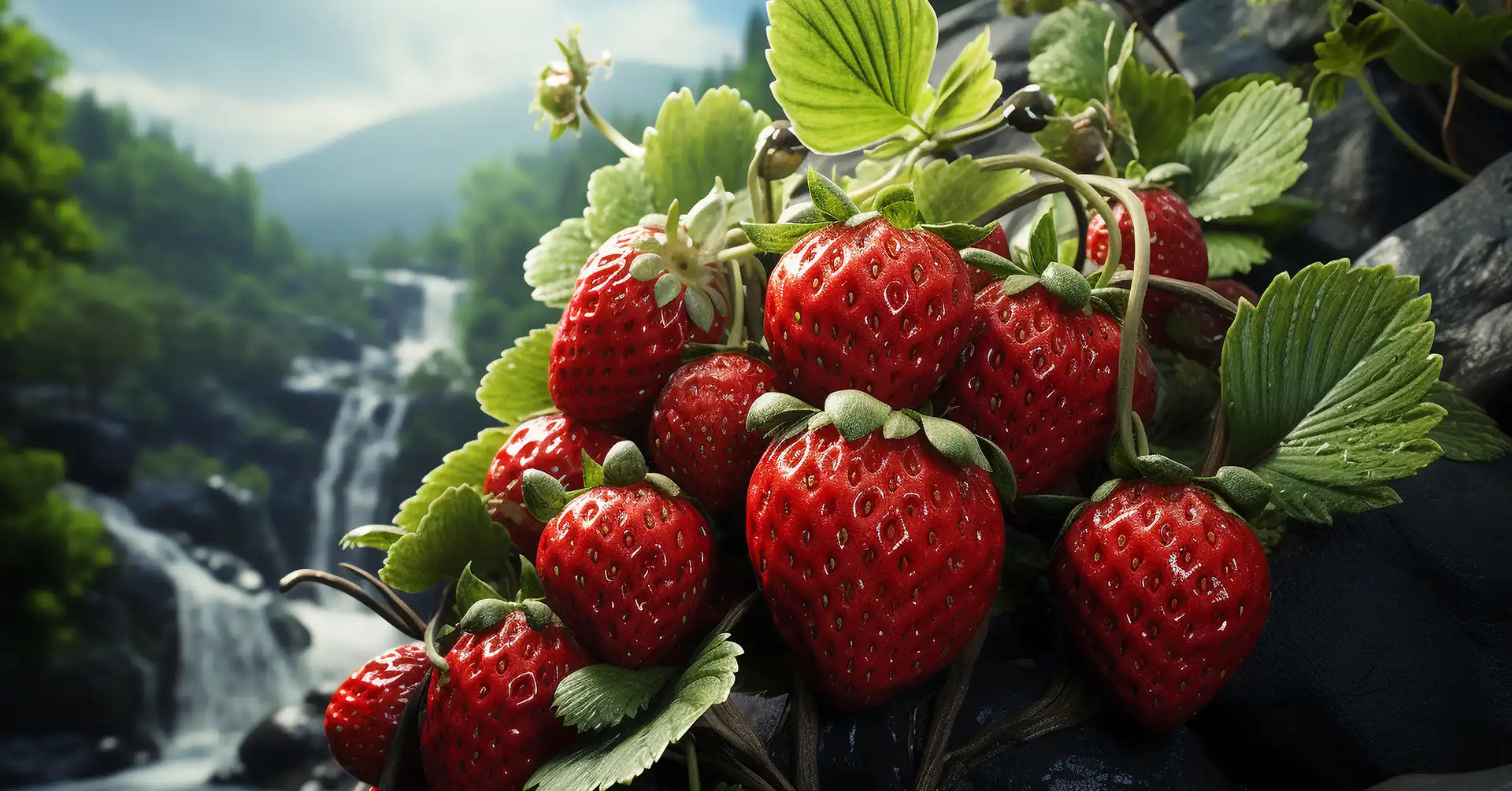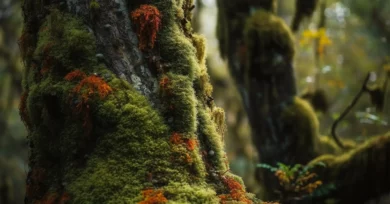Mock strawberries, also known as Indian strawberries or Duchesnea indica, are small, red fruits that resemble true strawberries but have a distinct lack of flavor. They grow close to the ground, often found in lawns, gardens, and along roadsides. Mock strawberries originated in Southeast Asia. They were introduced to the United States in the 19th century as an ornamental ground cover due to their hardy nature and attractive foliage. Over time, they escaped cultivation and spread across various regions of the country. These plants thrive in a wide range of environments, from sunny gardens to shady woodland areas. They are particularly common in the southeastern US, where they often form dense mats in lawns and parks. As they spread, many people wonder, can you eat mock strawberries? The answer is yes, but their taste is bland compared to true strawberries.
Visual Differences Between Mock Strawberries and Wild Strawberries
Mock strawberries and wild strawberries can look quite similar, making it important to know how to tell them apart. Here are some key visual differences:
Flower Color and Shape:
Mock strawberries have yellow flowers, while wild strawberries boast white or light pink flowers. This is one of the easiest ways to distinguish between the two. When you’re asking, “are mock strawberries edible,” start by checking the flower color.
Leaf Structure:
The leaves of mock strawberries are often more rounded with a slight crinkle, whereas wild strawberry leaves are more sharply toothed and have a pronounced veining pattern. If you’re ever in doubt and wondering, “can you eat mock strawberries,” examining the leaf structure can be very helpful.
Fruit Appearance:
Mock strawberries produce small, round, red berries that have a bumpy texture similar to a raspberry. In contrast, wild strawberries have conical, juicy fruits that look more like the strawberries you buy at the store. This visual difference is crucial when considering, “Can you eat mock strawberries.”
Fruit Position:
The fruits of mock strawberries often point upwards and are held above the leaves on a stem, making them more visible. Wild strawberries, however, tend to hang down closer to the ground. Noticing this can help you decide, “Can you eat mock strawberries.”
Can You Eat Mock Strawberries?
Yes, you can eat mock strawberries. Though they are not toxic and are safe to eat, many people find their flavor lacking compared to true strawberries. Mock strawberries (Duchesnea indica) are often found in gardens and lawns across the United States. Despite their unappealing taste, they are harmless and can be a fun foraging discovery.
Nutritional Value and Taste
Mock strawberries are not particularly known for their taste, which is often described as bland or slightly bitter. When wondering, “Can you eat mock strawberries,” it’s helpful to know that while mock strawberries are edible, they do not offer much in the way of flavor. However, they do contain small amounts of nutrients.
Mock strawberries provide minimal nutritional value compared to true strawberries. They contain small amounts of vitamins and minerals, such as Vitamin C and iron. While not a nutritional powerhouse, if you’re curious and ask, “Can you eat mock strawberries,” rest assured they are safe, albeit not very satisfying.
Recipes Featuring Mock Strawberries
Mock strawberries may not be as flavorful as their wild counterparts, but they can still add a unique touch to various dishes. Here are some simple ways to incorporate them into your meals:
- Mock Strawberry Salad: Toss mock strawberries with fresh greens, goat cheese, and a light vinaigrette for a refreshing salad. The mild taste of the berries pairs well with tangy cheese and zesty dressing.
- Mock Strawberry Jam: Cook mock strawberries with sugar and lemon juice to create a homemade jam. Spread it on toast or use it as a filling for pastries. While it won’t be as sweet as regular strawberry jam, it’s a fun and novel way to use these berries.
- Smoothie Boost: Add a handful of mock strawberries to your morning smoothie. Blend them with bananas, yogurt, and honey for a healthy and visually appealing drink.
Historical and Modern Uses
Historically, mock strawberries were often overlooked in favor of their sweeter relatives. However, they have been used in traditional medicine and as a decorative plant. In modern times, they have found a place in gardens as ground cover due to their resilience and low maintenance needs.
Today, some adventurous cooks and foragers use mock strawberries in various dishes. From salads to jams, people are finding creative ways to answer the question, “Can you eat mock strawberries?” and incorporate them into their diet. They might not be a staple, but they certainly add an interesting twist to familiar recipes.
Health Considerations
Potential Benefits
Mock strawberries might not pack a punch in flavor, but they do come with some potential health benefits. They are low in calories and contain vitamins like Vitamin C and trace amounts of minerals. Including them in your diet can be a way to add variety and a bit of nutritional value without adding too many calories.
Additionally, the leaves of mock strawberry plants have been used in traditional herbal remedies. Some believe they can help with minor ailments, although scientific evidence is limited. When considering, “can you eat mock strawberries?” it’s worth noting that their nutritional profile, while modest, can contribute to a balanced diet.
Possible Risks and Allergies
While mock strawberries are generally considered safe to eat, some people might experience mild allergic reactions. Symptoms can include itching or a slight rash. If you’re trying them for the first time, start with a small amount to see how your body reacts.
Growing Mock Strawberries in Your Garden
Mock strawberries, with their bright red berries and yellow flowers, can add a pop of color to your garden. If you’re considering adding them to your space, here are some tips:
- Soil and Sunlight: Mock strawberries thrive in well-drained soil and prefer full sun but can tolerate partial shade. Prepare your garden bed with compost to enrich the soil.
- Planting: Plant mock strawberries in early spring. Space the plants about a foot apart to allow room for growth.
- Watering: Keep the soil consistently moist, especially during the first few weeks after planting. Once established, they are fairly drought-tolerant.
- Maintenance: Remove weeds regularly and mulch around the plants to retain moisture and prevent weed growth. Prune back any dead or overgrown parts to keep your garden looking tidy.
Growing mock strawberries is simple and can make your garden look beautiful. As you enjoy their beauty, you might wonder, “Can you eat mock strawberries?” They are safe to eat but often described as bland.
Managing Their Spread
Mock strawberries are known for their ability to spread quickly, which can be both a blessing and a curse. Here’s how to manage their growth effectively:
- Containment: To prevent mock strawberries from taking over your garden, consider planting them in containers or raised beds. This limits their ability to spread via runners.
- Regular Monitoring: Check your garden regularly for new shoots. Remove any unwanted growth promptly to keep the plants from spreading too much.
- Barriers: Install garden borders or underground barriers around planting areas to block the runners from spreading beyond designated areas.
- Companion Planting: Plant mock strawberries alongside other ground covers that can compete with them for space, helping to control their spread naturally.
Managing the spread of mock strawberries ensures they don’t overwhelm other plants in your garden. Remember, if you’re ever curious about “can you eat mock strawberries,” the answer is yes, though they might not be the tastiest addition to your meals.
Additional Tips
- Fertilizing: Use a balanced fertilizer during the growing season to promote healthy growth.
- Pest Control: Mock strawberries are generally pest-resistant, but keep an eye out for common garden pests like aphids. Use natural or chemical treatments as needed.
- Winter Care: In colder regions, mulch heavily around the plants to protect them from frost.
With these tips, you’ll have a beautiful and controlled mock strawberry patch. If you ever ask yourself, “can you eat mock strawberries,” remember that while they are edible, they may not be the most flavorful snack in your garden.
FAQs
Are Mock Strawberries Poisonous to Pets?
False strawberries are generally safe for pets. Unlike some wild berries, they do not contain toxic substances that could harm your dog or cat. However, since they offer little nutritional value, it’s best to keep your pets from eating too many. If you’re wondering, “Can you eat mock strawberries?” the same applies to pets—they’re edible but not particularly beneficial.
How Can I Tell the Difference Between Mock Strawberries and Wild Strawberries?
Mock strawberries and wild strawberries look similar, but you can tell them apart by their flowers and fruit. Mock strawberries have yellow flowers and less flavorful, dry berries. Wild strawberries, on the other hand, have white flowers and sweet, juicy fruit. So, when you ask, “Can you eat mock strawberries?” remember they are safe, but not as tasty as wild strawberries.
Do Mock Strawberries Have Medicinal Uses?
While mock strawberries have been used in traditional medicine in some cultures, there is no strong evidence to support any significant health benefits. They are often used in folk remedies for skin conditions and minor cuts. But if your question is, “Can you eat mock strawberries for health benefits?” the answer is they’re safe to eat but not a health powerhouse.
Can You Eat Mock Strawberries?
Yes, you can eat mock strawberries. They are non-toxic and safe for human consumption. However, don’t expect a burst of flavor—they are quite bland compared to regular strawberries. People often ask, “Can you eat mock strawberries in recipes?” You can, but they usually don’t add much taste. They’re best used as a garnish or a visual addition to dishes.
Conclusion
Mock strawberries, while safe and edible, are not known for their taste or nutritional benefits. They can be easily identified by their yellow flowers and dry, bland fruit, distinguishing them from the sweeter wild strawberries. Although they may not offer significant culinary or medicinal value, they are harmless and can even add a touch of color to your garden or plate. So, can you eat mock strawberries? Yes, you can, but they are best enjoyed for their ornamental appeal rather than their flavor.
Also Read:
Gardening Aesthetic that will Redefine your Garden!(Opens in a new browser tab)






